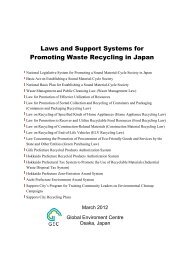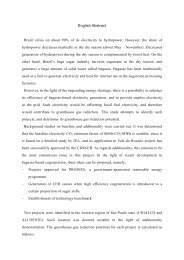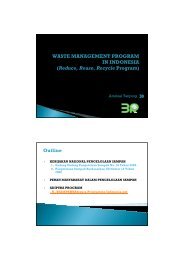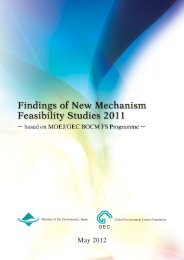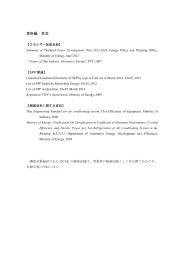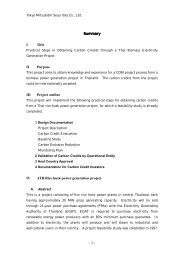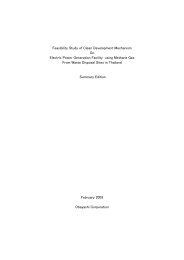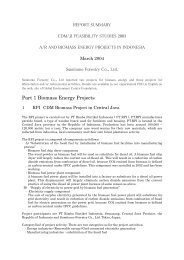PDF File - GEC
PDF File - GEC
PDF File - GEC
Create successful ePaper yourself
Turn your PDF publications into a flip-book with our unique Google optimized e-Paper software.
activity or due to force majeure.<br />
(d) In establishing a baseline the project participants shall draw on the list of standard variables<br />
contained in Appendix B to the guidance on criteria for baseline setting and monitoring, as<br />
appropriate.<br />
(e) The project participants shall justify their choice of baseline taking into account Annex 1 to the<br />
guidance on criteria for baseline setting and monitoring, which explains about additionality.<br />
If the baseline approach chosen differs from approaches already taken in comparable cases<br />
(same GHG mitigation measure, same country, similar technology, similar scale) that an AIE<br />
has positively determined, the differences shall be explained and justified.<br />
(f) In any case:<br />
• The project participants shall set a baseline in accordance with Appendix B of the JI<br />
guidelines;<br />
• The host Party/Parties (as well as the other Parties involved) has/have to approve the<br />
project; and<br />
• The AIE has to determine whether the project has an appropriate baseline in accordance<br />
with the criteria set out in Appendix B of the JI guidelines.<br />
(2) Monitoring<br />
Criteria for monitoring [JI guidelines, Appendix B]<br />
(a) Project participants shall include, as part of the PDD, a monitoring plan that provides for:<br />
(i) The collection and archiving of all relevant data necessary for estimating or measuring<br />
GHG emissions and/or removals occurring within the project boundary during the<br />
crediting period;<br />
(ii) The collection and archiving of all relevant data necessary for determining the baseline of<br />
GHG emissions and/or removals within the project boundary during the crediting period;<br />
(iii) The identification of all potential sources of, and the collection and archiving of data on<br />
increased GHG emissions and/or reduced removals outside the project boundary that<br />
are significant and reasonably attributable to the project during the crediting period. The<br />
project boundary shall encompass all GHG emissions and/or removals under the control<br />
of the project participants that are significant and reasonably attributable to the JI project<br />
activity;<br />
(iv) The collection and archiving of information on environmental impacts, in accordance<br />
with procedures as required by the host Party, where applicable;<br />
(v) Quality assurance and control procedures for the monitoring process;<br />
(vi) Procedures for the periodic calculation of the GHG emission reductions and/or<br />
enhancements of removals by the proposed JI project, and for leakage effects, if any.<br />
Leakage is defined as the net change of GHG emissions and/or removals which occurs<br />
outside the project boundary, and that is measurable and attributable to the JI project;<br />
(vii) Documentation of all steps involved in the calculations referred to in subparagraphs (ii)<br />
and (vi) above.<br />
(b) Revisions, if any, to the monitoring plan to improve its accuracy and/or completeness<br />
of information shall be justified by project participants and shall be submitted for the<br />
determination referred to in paragraph 37 of the annex on JI guidelines by the accredited<br />
independent entity.<br />
(c) The implementation of the monitoring plan and its revisions, as applicable, shall be a condition<br />
for verification.<br />
74




